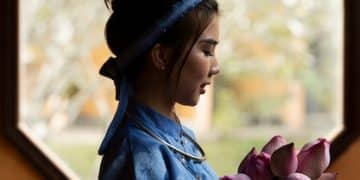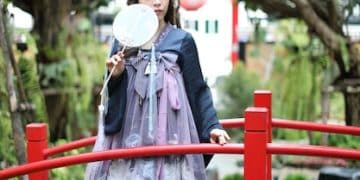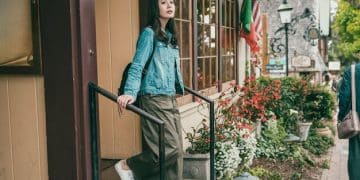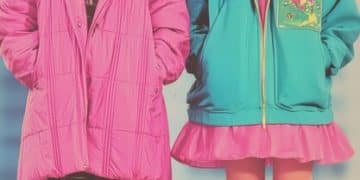Hanbok in the US: Finding Authentic Korean Styles
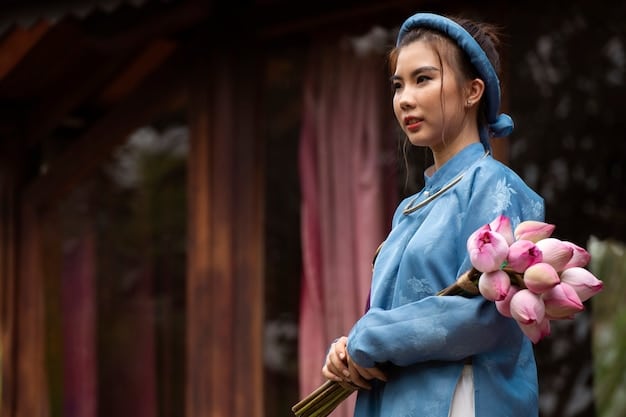
The rising popularity of Hanbok in the US stems from its cultural significance and stunning designs; authentic styles can be found in specialized boutiques, online stores, and through bespoke designers.
The vibrant colors and elegant lines of the Hanbok in the US are captivating fashion enthusiasts. But where can one find truly authentic styles that honor this traditional Korean garment?
The Allure of Hanbok: A Cultural Icon
The Hanbok extends beyond simple clothing; it represents centuries of Korean history, values, and artistic expression. Understanding its cultural significance further fuels its appeal in the US.
The Hanbok has a rich history, evolving through royal court ceremonies to everyday wear. Traditional Hanboks consist of a jeogori (jacket), baji (pants) for men or chima (skirt) for women, and a goreum (coat).
Historical Roots and Evolution
Originating from the Three Kingdoms period of Korea, the Hanbok’s silhouette and features have undergone gradual transformation. Variations reflect societal status, region, and era.
- Royal Hanbok: Intricate designs, luxurious fabrics, and symbolic colors distinguished those worn by royalty.
- Commoner’s Hanbok: Simpler materials and muted tones reflected the practical demands of daily living.
- Modern Adaptations: Contemporary designers blend traditional elements with modern sensibilities, creating innovative variations.
Modern Hanbok adaptations often simplify the silhouette for comfort and practical wear, combining ease of movement with tradition.
K-Dramas and the Hanbok Renaissance
K-dramas have played a pivotal role in showcasing the beauty of the Hanbok to global audiences. The visual appeal of these costumes enhances storytelling and stimulates cultural curiosity.
Dressed in vibrant and meticulously crafted hanboks, period dramas like “Kingdom,” “Mr. Sunshine,” and “Empress Ki” spotlight the grandeur of the garment against dramatic backdrops.
Impact of K-Dramas on Fashion Trends
These depictions prompt interest in traditional Korean clothing and inspire fashion trends; viewers find the cultural roots embedded in each garment intriguing.
Beyond screen appearances, many K-pop idols and celebrities don Hanboks for special occasions and photoshoots. This exposure influences fashion enthusiasts, cementing the Hanbok’s status as a sought-after garment.
K-dramas emphasize not only the visual splendor of the Hanbok but also the cultural values it represents. Elements like etiquette, familial respect, and filial piety get highlighted, creating additional layers of understanding.
Finding Authentic Hanbok Styles in the US
Sourcing authentic Hanboks in the US requires choosing retail locations and online vendors that possess in-depth knowledge of the garment’s craftsmanship, materials, and cultural significance.
Several avenues exist for obtaining traditional and modern Hanboks. Specialized boutiques, online stores, and bespoke designers offer a range of styles to select.
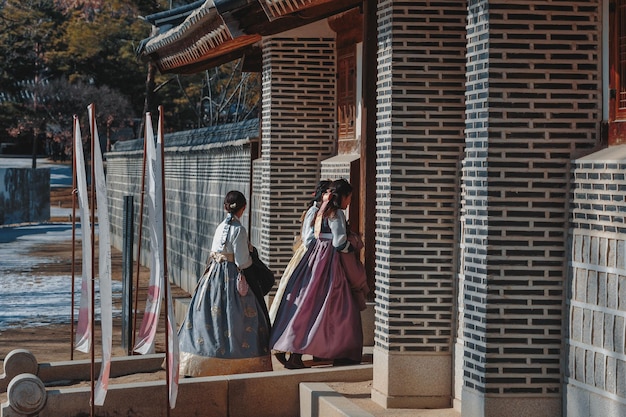
Specialized Boutiques in Koreatowns
Visiting boutiques in Koreatowns across the US provides in-person access to a range of Hanbok options. Staffed with culturally informed personnel, these stores offer guidance on selecting the right attire.
These boutiques often host trunk shows and events that feature new designs and bespoke services. Such events allow customers to engage directly with designers and gain insights into tailoring processes.
- Expert Consultation: Knowledgeable staff assists in selecting attire based on occasion, body type, and personal taste.
- Quality Assurance: Inspecting the craftsmanship of each garment ensures the authenticity and durability of materials.
- Customization Options: Boutiques provide professional alteration services, ensuring a perfect fit.
Selecting an establishment that provides genuine, high-quality garments combined with personalized consultations makes the Hanbok experience more special.
Navigating Online Hanbok Retailers
A growing number of online retailers offer a diverse assortment of Hanboks. Critical assessment of factors such as vendor reputation, certification, and customer feedback is essential.
Selecting a credible online vendor requires conducting due diligence that includes reviewing customer reviews, verifying garment details, and cross-referencing vendor credentials.
Essential Tips for Safe Online Shopping
Prioritize retailers that provide comprehensive product details, secure payment gateways, and clear return policies to ensure customer satisfaction.
Reputable online sellers typically provide professional photography showcasing materials, stitching, and embellishments. They also offer detailed sizing charts and informative fashion guidelines.
- Check Vendor Credentials: Look for vendors who are certified by recognized Korean cultural organizations.
- Read Customer Reviews: Assess positive and negative feedback to gauge vendor credibility.
- Ensure Secure Transactions: Verify that payment processes are encrypted to protect personal data.
Being proactive in verifying a retailer’s reliability is vital to an assured purchase.
Bespoke Hanbok Designers: Tailoring Tradition
Engaging bespoke Hanbok designers allows individuals to tailor attire to specific needs and preferences. This personalized approach ensures the fit, fabric selection, and design harmonize perfectly.
Working with a bespoke designer offers unparalleled access to one-of-a-kind creations. Designers merge traditional styles with contemporary elements, creating garments that represent unique cultural identities.
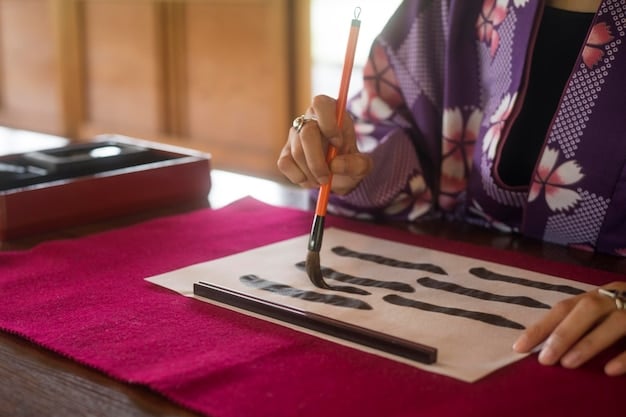
Benefits of Choosing Bespoke Services
Choosing bespoke Hanbok designers offers multiple benefits, including personalized attention, exclusive fabric availability, and detailed fitting adjustments.
These designers take time to listen to clients’ wishes, using their skill to translate concepts into tangible designs. Factors include fabric types, embroidery styles, color selection, and silhouette shape.
- Customized Fit: Designs are made to each client’s exact measurements, ensuring ultimate comfort and fit.
- Fabric Choices: Designers provide access to premium fabrics sourced directly from Korea.
- Unique Embellishments: Intricate embroidery, beadwork, and hand-painted patterns add to customized designs.
Opting for bespoke services offers a refined, personalized way to connect intimately with Korean cultural heritage, resulting in a precious garment.
Caring for Your Hanbok: Preservation Tips
Maintaining the long-term beauty and condition of your Hanbok requires proper care and attentive cleaning practices. Handling these sensitive textiles thoughtfully helps prevent damage.
Different fabrics require different cleaning techniques. Natural silks and intricate embroideries benefit from professional care, while modern blends may tolerate gentle home laundering.
Best Maintenance Practices
To ensure the longevity of your Hanbok, practice thoughtful maintenance routines like prompt stain removal, proper storage, and occasional professional cleaning.
Proper wrapping and careful folding prevents creasing and distortion, ensuring that future generations can enjoy these cultural heirlooms as well.
- Professional Cleaning: Seek out dry cleaners familiar with sensitive fabrics like silk and ramie.
- Proper Storage: Use acid-free tissue paper to wrap and store Hanboks in breathable garment bags.
- Avoid Direct Sunlight: Keep attire away from direct sunlight, which can fade colors and weaken fibers.
By committing to proper maintenance, Hanbok owners extend the lives of their garments and preserve important parts of Korean cultural heritage. This respectful care creates tangible links across generations.
| Key Aspect | Brief Description |
|---|---|
| 👗 Cultural Significance | Hanbok represents Korean history, values, and artistic expression. |
| 🎬 K-Drama Influence | Dramas showcase Hanbok beauty, prompting global interest. |
| 🛍️ Finding Authentic Styles | Explore boutiques, online stores, and bespoke designers in the US. |
| ✨ Maintenance Tips | Proper cleaning and acid-free storage ensure long-term garment preservation. |
Frequently Asked Questions
▼
An authentic Hanbok is typically defined by its traditional design, high-quality silk or ramie fabric, and meticulous craftsmanship. It should reflect Korean cultural aesthetics and historical accuracy.
▼
K-dramas expose a global audience to the Hanbok’s beauty and elegance, driving up interest and demand. These shows often showcase the garment in historically accurate and visually stunning ways.
▼
You can discover Hanboks at specialized boutiques in Koreatowns, through online retailers, or by commissioning a bespoke designer. Each option provides different levels of customization and authenticity.
▼
Traditional Hanboks are typically made from silk or ramie. Silk is prized for its luxurious feel and sheen, while ramie is a durable, lightweight option used especially in warmer seasons.
▼
It’s best to have your Hanbok professionally cleaned by a dry cleaner who is familiar with delicate fabrics like silk. Properly store it in a breathable garment bag with acid-free tissue paper to preserve its condition.
Conclusion
The journey to find and own authentic Hanbok in the US is more than just a shopping trip; it’s an exploration of heritage, craft, and personal style. Whether you choose a boutique, delve into online sources, or seek a bespoke designer, each step connects you more deeply with the garment’s essence and cultural richness.
